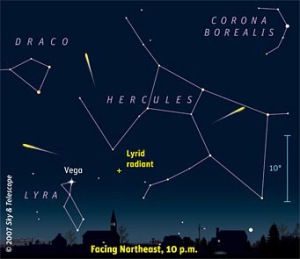The clocks have gone forward! Between February, March and the beginning of April, there isn’t an X amount of astronomical events that have occurred. Astronomers await for much clearer and crisp skies and warmer weather to view some extraordinary shows that are expected.
Next event:
The next major meteor shower will be April 22nd until the dawn of April 23rd. Lyrids Meteor shower consists of around 15 meteors an hour, which is small compared to Quadrantids in January (40 meteors hourly!)
Time and a place – Don’t miss out on Lyrids!
The “April showers” Will be bright bursts of light and leave long trails of meteor dust across the sky at the site of the Lyra and Vega constellations. It is easily viewed outside in your garden and looking up towards northeast in the sky. The best place to view the shower depends on where you live. Areas with the least amount of light would be advised.
The best time to view the shower would be around 10p.m GMT time. Unfortunately, there will be a waning gibbous moon that night which will cause failure to view for some people in different parts of the country. The light reflected off the moon will disrupt the show, causing less meteors to be viewed if you wish to view the shower later in the night.
General knowledge of Lyrids:
- Lyrids meteors descend from its parent Comet Thatcher (Also known as C/1861 G1).
- Lyrids has had cases of break-through records, consisting of 100+ meteors per hour! These outbursts are quite rare and it is difficult when to predict them.
- On April 26th, 1803, a shower of thousands of small rocks fell from the sky in northwestern France and terrified people!
- Earth travels through the tail end of Thatcher.
Best of luck with viewing the shower!



